Information Board

- Information Board
- Composition of Taekwondo
- Sparring

Nakbeop (breakfall) Techniques includes a set of techniques that protect the body from hitting the floor or becoming off-balance by decreasing the pressure exerted on the body. The trainee should place their palms on the ground, while being careful not to sprain their wrists. Specifically, they should protect their head from hitting the floor by pulling the chin down or turning the neck.
The types of Nakbeop (breakfall) include Jeonbangnakbeop (front breakfall), Hubangnakbeop (back breakfall), Cheukbangnakbeop (side breakfall), Hoejeon Gureugi
(rolling breakfall) and Gongjung Hoejeon Nakbeop (air-rolling breakfall).
Read more
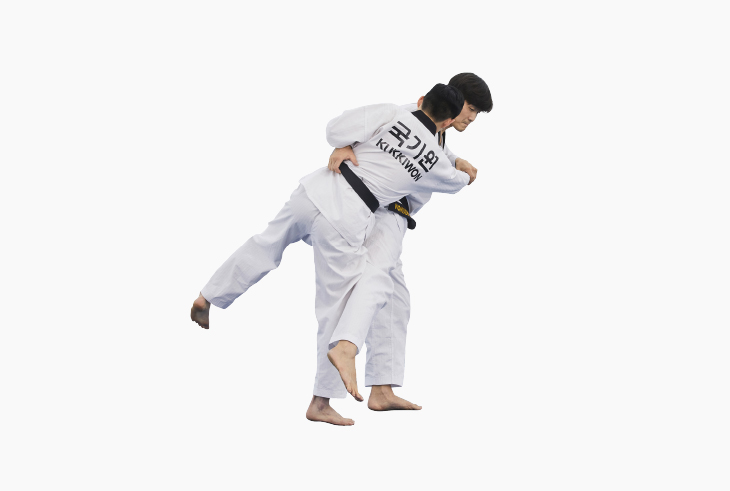
Neomgigi (take down) includes a set of techniques of breaking the opponent’s center of gravity by using arms and legs. The direction the arm acts and the direction the leg acts are opposite to each other. To take down the opponent, the trainee’s center of gravity must be stronger than that of the opponent; therefore, a trainee should possess a strong lower body and trained core muscles. A Taekwondo trainee should execute Take Down swiftly without preliminary motions, while ensuring that the motions are not excessively large. The trainee should use the body's elasticity (waist and ground reaction force) and execute Ditgi (stepping) simultaneously. When tripping or grasping, the trainee should maintain their center of gravity and keep their body close to the opponent. The trainee should quickly prepare for the next movement. The types of Neomgigi (take down) include Georeoneomgigi (tripping up), Ogeum georeoneomgigi (popliteal fossa tripping up), Deureoneomgigi (throwing down) and Eopeoneomgigi (shoulder throw).
Read more

Pihagi (dodging) includes a set of techniques of defending against an opponent’s attack without physical collision by moving the body. It is designed to enable a Taekwondo trainee to avoid an attack by moving the entire body such as twisting, bending the upper body through a twist, leaning back, and stepping. The trainee should perform these motions swiftly without preliminary motions, and avoid making them excessively large. Additionally, the trainee should use the body’s elasticity (rotational force generated from the twisting of the waist and ground reaction force) and Ditgi (stepping). The trainee should always keep an eye on their opponent and protect their chin with both hands. The trainee should quickly go back to Junbijase (ready stance) to prepare for a series of attacks.
The types of Pihagi (dodging) include Teureopihagi (rolling), Biteureopihagi (weaving), Sugyeopihagi (ducking in place), Jeotyeopihagi (back leaning) and Sugyeopihagi (left ducking, right ducking).
Read more
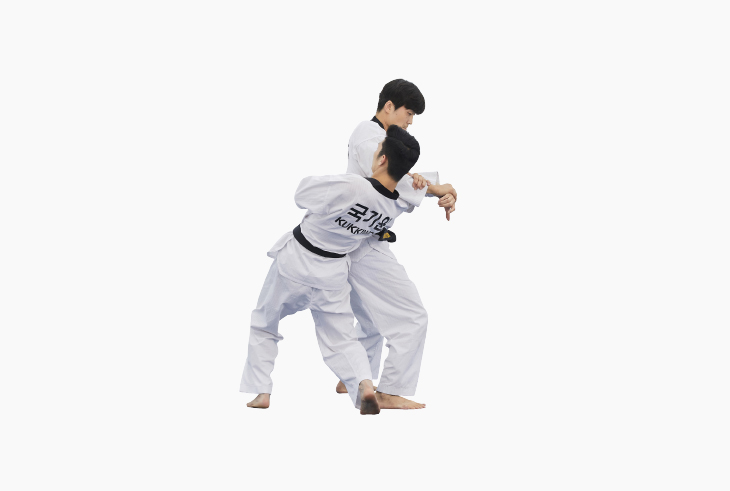
Kkeokgi (joint-lock) includes a set of techniques of restraining by using the principle of levering, pressing, or twisting and pulling out the hand from the opponent’s grasp by the Makgi (blocking) technique; thus, many things can be applied to Joint-Lock. Kkeokgi (joint-lock) should be performed swiftly without preliminary motions, and while ensuring that the motions are not excessively large. The trainee should use the opponent’s balance and direction of force to their advantage. Additionally, the trainee should use the body’s elasticity (rotational force generated from the twisting of the waist and ground reaction force) to perform Ditgi (stepping) and Kkeokgi (joint-lock) simultaneously. To control the direction of the opponent’s hand, the position of the gripping hand should be close to the joint of the opponent’s arm. The trainee should quickly find their center of gravity after the movement.
The types of Kkeokgi (joint-lock) include Biteureokkeokgi (inward twist joint lock, outward twist joint lock), Nulleokkeokgi (press joint lock), Georeokkeokgi (tripping joint lock) and Songarakkkeokgi (finger joint-lock).
Read more
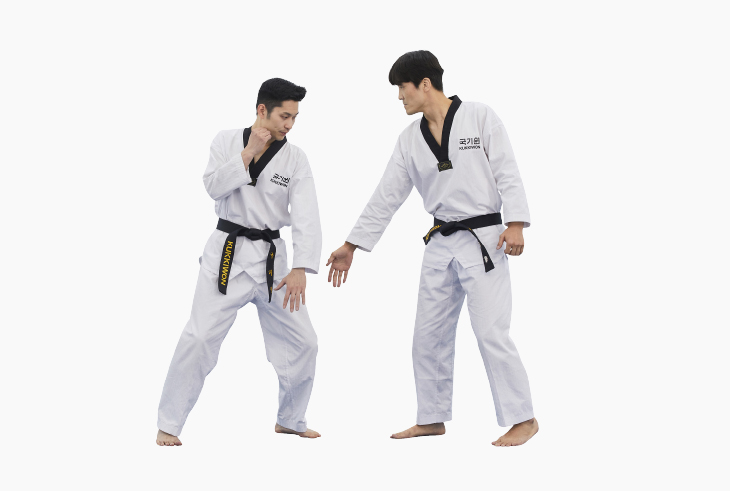
This technique is used to pull out a part of the body (mainly the wrist) when it is grabbed by the opponent. This technique should be performed swiftly without preliminary motions, and while ensuring that the motions are not excessively large. The trainee should use the opponent’s balance and direction of force to their advantage. Subsequently, they should use the body’s elasticity (rotational force generated from the twisting of the waist and ground reaction force) to perform Stepping (Ditgi) and Pulling Out (Ppaegi) simultaneously. The trainee should raise the opposite hand to the side of the face to defend themselves and adopt a stance for the next movement. They should quickly find the center of gravity after the movement. They can perform the pulling out motion more easily by kicking the opponent’s leg or pushing the opponent’s shoulder to knock the opponent off balance.
The types of Ppaegi (pull away) include Naeryoppaegi (downward pull away), Ollyeoppaegi (upward pull away), Teureoppaegi (inward turning pull away, outward turning pull away), Dollyeoppaegi (upward rotate pull away, downward rotate pull away)
Read more
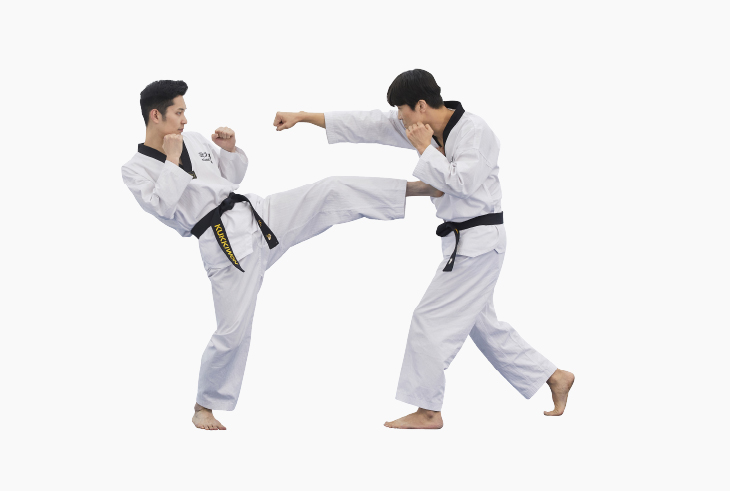
This technique is executed by making use of the ball, instep, and sole of the foot, back of the heel, and the shin. It is performed without preliminary movements, while attempting to not kick too high or make excessively large movements. The opposite hand should be pulled in to protect the chin, and the and use the action-reaction from the trunk’s rotational moment of inertia and push of from the ground. The trainee should maintain their balance after kicking.
The types of Chagi (kicking) include Apchagi (front kick), Dollyeochagi (roundhouse kick), Biteureochagi (twist kick), Mireochagi (pushing kick) and Yeopchagi (side kick).
Read more
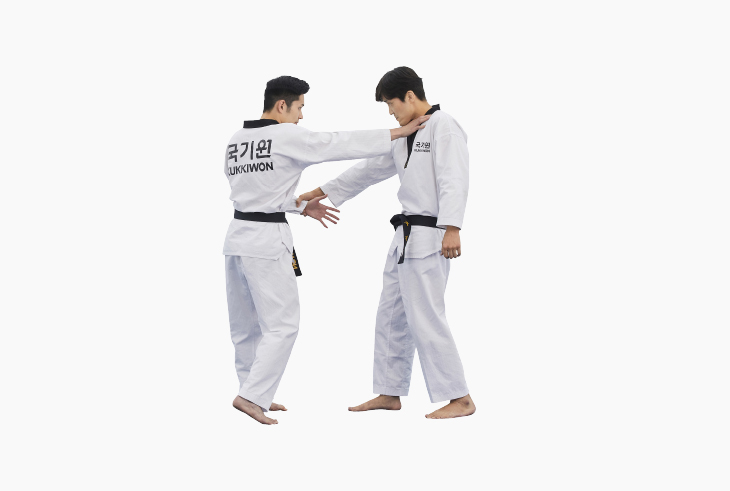
This technique is executed by striking using a hammer fist, palm hand, arc hand, elbow, and the knee. It should be performed without preliminary movements, and while ensuring that the striking hand does not extend out of the body to a large extent. The opposite hand should be pulled in to protect the chin, and the body’s elasticity (rotational force generated from the twisting of the waist and ground reaction force) should be used. After the movement, the trainee should quickly return to the basic position.
The types of Chigi (striking) include Mejumeok Naeryeochigi (hammer fist downward strike), Mejumeok Bakkatchigi (hammer fist outward strike), Batangson Chigi (palm hand strike), Ageumson Chigi (arc hand strike), Palkkumchi Pyojeokchigi (elbow target strike) and Mureup Chigi (knee strike).
Read more
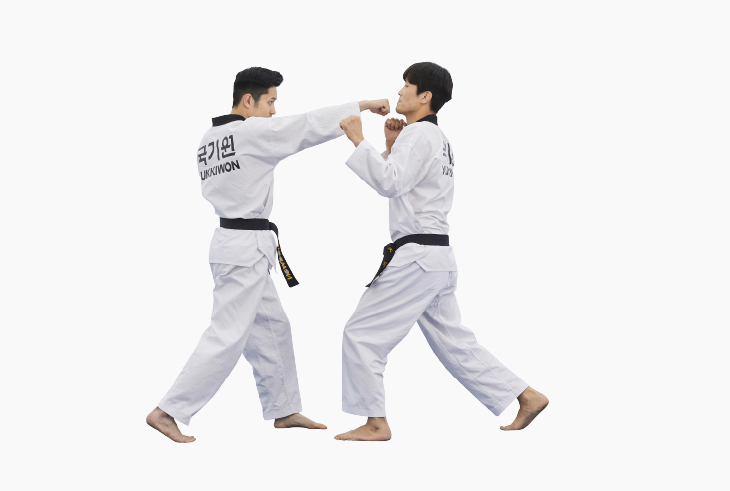
Punching indicates a set of techniques that are executed by using fists to attack an opponent. These include delivering a punch by throwing the fist in a straight line, traveling in a circular motion, turning the wrist vertically by using fingertips and a palm hand, and twisting the arm. These techniques are performed without a preliminary movement; while executing these techniques, it is necessary to ensure that the clenched fist does not extend out of the body to a large extent. The opposite hand should be pulled in to protect the chin, and the body’s elasticity (rotational force generated from the twisting of the waist and ground reaction force) is used. After the movement, the trainee should quickly return to the basic position.
The types of Jireugi (punching) include Dollyeojireugi (turning punch), Ollyeojireugi (upper-cut punch), Sewojireugi (upright punch) and Biteureojireugi (twist punch).
Read more

In this technique, a Taekwondo trainee should use their wrists to block an incoming attack as if they were hitting the opponent strongly and quickly with inward, outward, upper, and lower blocks. Mostly, the trainee uses their wrists, hammer fists, knife-hands, palm hands, and the back of your hands to execute this technique. When performing it without a preliminary movement, the blocking hand should not extend out of the body to a large extent. Additionally, the other hand should be pulled to protect the chin, and use the rotational moment of inertia and the actionꠓreaction pushing from the ground. After the movement, the trainee should quickly return to the basic position. Depending on the situation, household items such as cell phones, key chains, and pens should be used to subdue opponents with both defensive and offensive actions.
The types of Makgi (blocking) include Eolgulmakgi (face block), Bakkanmakgi (outward block), lower block, Araemakgi (low block) and Anmakgi (inward block).
Read more